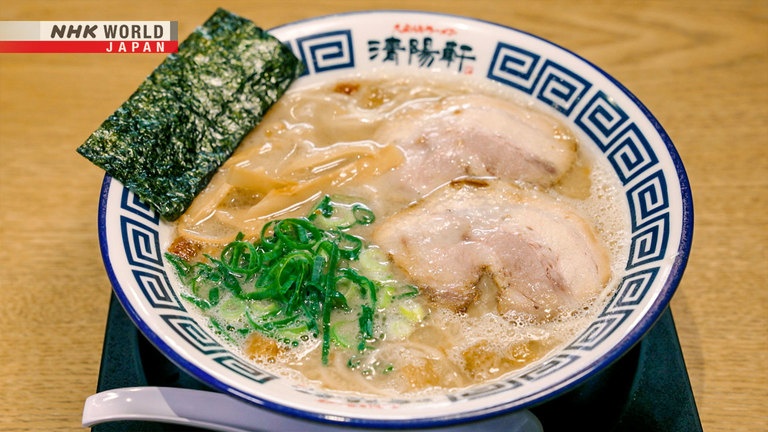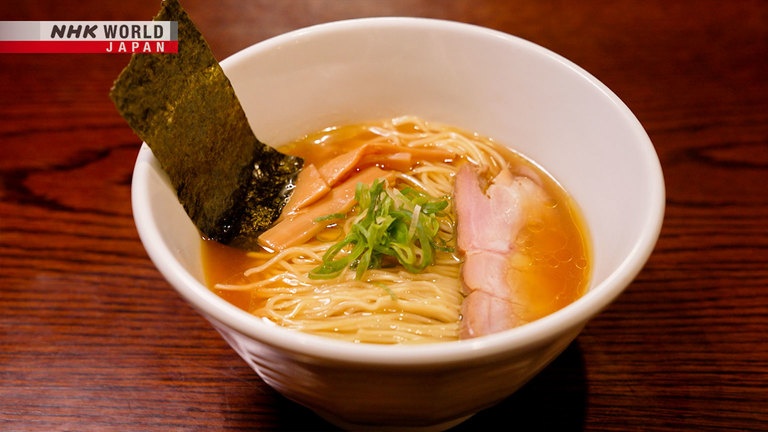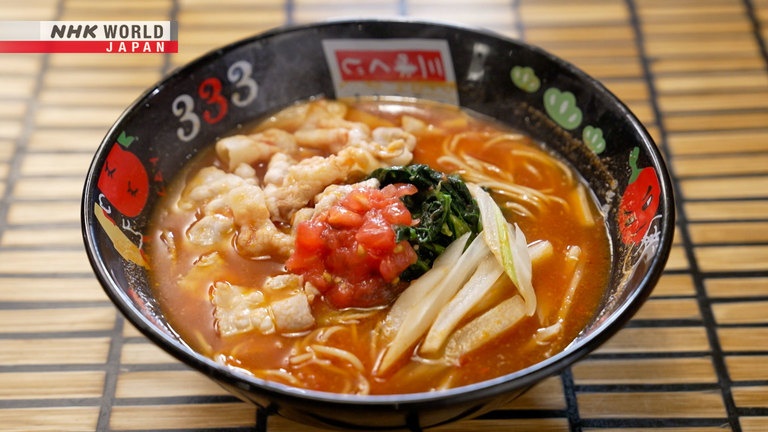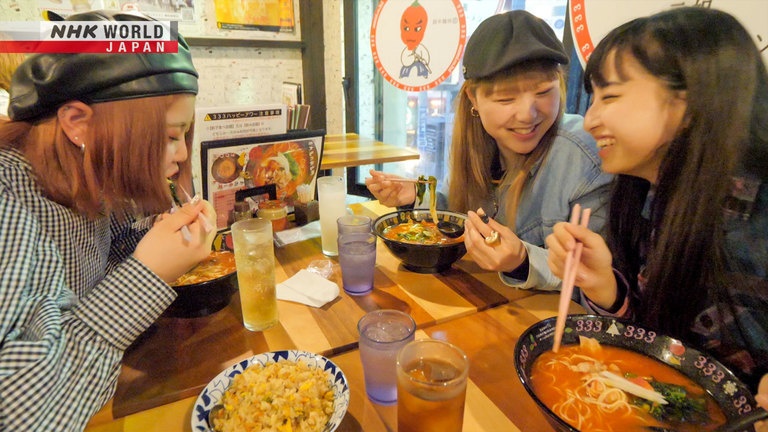TONKOTSU RAMEN: FUKUOKA Part 2
In the birthplace of tonkotsu ramen, we visit a long-standing shop specializing in the Kurume style. Learn the surprising story of this cloudy pork-bone broth ramen from those who love it best.




Transcript
Ramen...
A Japanese staple that's now popular worldwide.
Each region has its own vision, shifting with the times while staying true to the original.
Welcome to Japan, the land of ramen!
Continuing from last time, this is part two of "tonkotsu" ramen.
A journey through Fukuoka.
Kurume, Hakata, and Nagahama all vying for the top spot in this ramen-lover's paradise.
About 40km south of Fukuoka City.
Fukuoka Prefecture's third largest city, Kurume, with a population of around 300,000.
In front of the station, there are two monuments.
One is a massive tire.
This is the home of the Japanese rubber industry.
And a world-famous tire maker got its start here.
The other monument is a food stall.
Kurume is also the birthplace of the world-famous "tonkotsu" ramen.
Kurume ramen is all about the soup.
All we use are pork bones.
We keep the soup from the day before,
just adding more bones.
It's done each day, never emptying the pot.
Otherwise, it wouldn't be Kurume ramen.
Even on days when the shop is closed, the broth keeps on cooking.
It's the very soul of Kurume ramen.
It's been over 60 years since my father
opened our shop in 1954.
The soup has been going the entire time.
There's still a drop from the old days.
The soup is cooked in a "hagama."
Pots like these have been used to cook rice in Japan since ancient times.
The key feature is the rounded bottom.
A "hagama" creates convection.
The soup wouldn't mix the same way
if we used something else.
Unlike Hakata style, Kurume ramen
uses medium-thick noodles.
And they have always been tender,
a bit soft, with some tooth in the center.
It helps them interact with the soup.
When you slurp up the noodles,
the soup comes along with them.
1937.
Kurume's first ramen stall opens.
This is the actual birthplace of Kyushu's "tonkotsu" ramen.
"Tonkotsu" ramen expert Hara Tatsuo, says the original soup was clear, not cloudy.
Then, after WWII, around 1947,
the owner of the Sankyu ramen stall,
had made his soup in the usual way...
But one day, Sugino left the broth cooking while he ran some errands.
He asked his mother to check on it
and then went out.
When he came back late, it had just
kept on boiling and became cloudy.
He figured it wouldn't sell.
But it was near opening time,
so he seasoned it and tried some.
It was delicious,
and it's popularity spread.
This was the birth of cloudy broth.
After that, the local rubber industry continued to grow,
and the cloudy "tonkotsu" ramen became popular among the workers in Kurume's factories.
I order noodles on the tender side.
They taste better.
You can even eat them
with loose teeth!
It's just delicious,
rich and mellow.
This is real Kurume comfort food.
In 2009, former rival shops joined together to create the Kurume Ramen Association.
Yoshino was named chairperson.
Their aim was to promote Kurume ramen nationwide.
They participated in gourmet events all over Japan, working together to spread the word about Kurume ramen.
Ask me where I'm from,
and I won't say, "Fukuoka."
I'll just say, "I'm a Kurume boy."
This cloudy "tonkotsu" ramen is the pride of Kurume.
1952.
Kurume's third ramen shop opens for business.
The first owner, Katsuki Hiroshi started out in a small food stall.
Pork bones boiled for three days and continuously renewed; a simple bowl of ramen perfection.
"Nori" from the nearby Ariake Sea as a topping.
Crisp fried pork back fat, or "kari-kari," adds a delightful accent to the flavor.
It captured the hearts of the people of Kurume.
Ichiki Koji is one of them.
As a kid, even at a sushi place,
I'd say, "I want chu-chu!"
"Chu-chu" was what I called ramen.
I loved to eat ramen so much.
Starting out as just a customer, in 1986 he became Katsuki's apprentice.
And eight years later he inherited the shop.
The shop prospered thanks to its regular customers.
But in 2006, suddenly and without warning Ichiki closed up shop.
I was an artisan, not a merchant,
and not very good at diplomacy.
I was the type who would just tell
unhappy customers to get out.
The taste of Kurume inherited from the previous generation...
with that, the soup kept going for half a century was no more.
One of the regulars, happened to be there the day it closed.
Former convenience store operator, Takamatsu Takeshi.
When I tried to open the door,
a piece of paper said it was closed.
What?!
I felt like collapsing from shock.
And since then, I wanted
to find some way to revive it.
Takamatsu wrote Ichiki a letter.
"I want to bring
that ramen back..."
Kurume ramen is the best.
You have to take it seriously,
or it'll never turn out well.
Furukawa Hideki, who worked with Takamatsu also joined in.
The three of them together began a project to bring back the ramen they loved.
The previous owner, Katsuki Hiroshi, was delighted to hear the news from his hospital bed.
He had been diagnosed with terminal cancer and given six months to live.
The first thing Ichiki worked on was the very heart and soul of Kurume ramen, the soup.
The only way to make it was to try.
It didn't go well.
Maybe because I was starting from zero,
but when I was cooking it just felt wrong.
Half a year later and he'd made no progress.
But one day, eight months after the revival project began...
He called us and said, "I think
I may have got it right this time."
The day before, he'd taken the soup
to the previous owner for an opinion.
But Katsuki wasn't conscious anymore.
I made some and brought it for him.
And the next day he passed away.
Maybe he was waiting.
May 2009.
They saw the effort through, and the day of the reopening arrived.
The three made no announcement at all.
30 minutes before opening.
One customer after another started to line up outside.
The ramen they loved was reborn.
A huge line had formed.
They just kept coming and coming.
Asking, "Is this the original Seiyo-ken?!"
Most moving of all was an old woman
who actually cried as she ate.
She cried because she remembered
all the times she came with her family.
Ramen is truly amazing.
When you want to celebrate,
put some ramen on your plate!
Kurume just loves ramen.
We really do.
For Ichiki, the goal is still ahead.
I still can't quite get his flavor.
I want to taste the old man's ramen again.
If I could do that, then I'd cry.
The ramen you love is the best ramen.
I loved the ramen he made.
Born and raised in Fukuoka, "tonkotsu" ramen.
Some people here still search for the perfect bowl.
Of course, I grew up here,
so "tonkotsu" ramen is number one.
But I still want something different
every once in a while.
The ramen he offers is miso based.
This miso ramen comes from Hakata,
with a focus on local ingredients.
A blend of three types of Kyushu miso.
In fact, more and more ramen in Fukuoka doesn't feature the cloudy white "tonkotsu" soup.
I want to promote Fukuoka food culture
by offering different types of ramen.
This shop does shoyu ramen.
It's a chicken stock base
cooked for 8 to 10 hours.
Fukuoka is synonymous with "tonkotsu."
But I want this to be a generational favorite
and really take root here.
Believe it or not, the ramen he makes...
features a tomato-based soup.
I blend several varieties of tomatoes
with vegetable stock.
It's all vegetables, entirely vegan.
Nice!
That's all for this time.
But there's so much more ramen out there to enjoy!
Wouldn't you like some yourself?
Come pay a visit for the best bowl of ramen you've ever had!